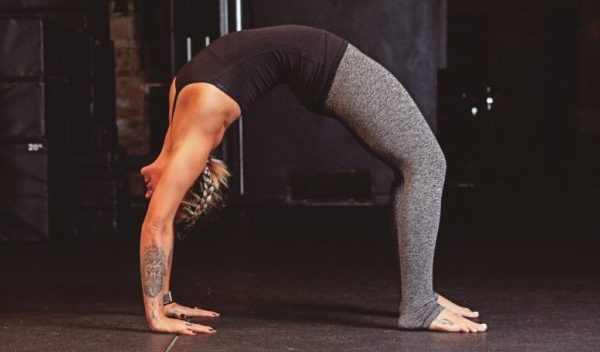Articles, In the Press, Megan Kearney, Resources, Yoga Medicine® News
How to Practice Hot Yoga Safely
Christina Heiser for A Sweat Life shares some safety tips for those looking to explore hot yoga for the first time.
How to Practice Hot Yoga Safely
You probably have plenty of yoga classes under your belt. After all, yoga has a ton of health benefits including increasing your flexibility and boosting your mood, so it’s a great type of exercise to do regularly.
Now, hot yoga studios are popping up in cities across the country, offering a steamy take on a classic. The theory is that the heat—a room will be anywhere from the 80-105 degree range depending on what practice of yoga you take—allows your muscles to open up more so that you get a deeper workout.
But that heat can do a number on you, so it’s important to follow a few basic guidelines. Top yoga instructors share their best tips for surviving hot yoga.
Ease your way into hot yoga.
Skip flow or power flow classes if you’re a hot yoga first-timer, as these classes may be too intense for beginners, says yoga instructor Vanessa Barthelmes. Instead, try Yin yoga in a heated room. “This allows your flexibility to increase and you can wind down from a hard day,” says Barthelmes.
Megan Kearney, Yoga Medicine® instructor, says that if you’re over 40, consider establishing a regular yoga practice before moving into a heated room. She also says anyone can benefit from giving themselves a couple of weeks to build to the heat. “Start by attending classes that are warm and build to the hotter classes,” says Kearney.
Make water a priority before, during, and after class.
It’s super-important to drink water before, during, and after a hot yoga class.
“Hydrate before class, because if you’re not hydrated, it makes a huge difference,” says Kendra Thomas, yoga instructor at NEO U in New York City. Barthelmes suggests bringing a large water bottle with you and keeping it near your side you can sip whenever needed. “You don’t want to practice with a belly full of water so simply take it as you need,” she says.
After class, Thomas recommends replenishing with electrolytes (which you can find in coconut water) to avoid dehydration and muscle cramps.
Wear the right clothes.
Sure, you want to look cute during hot yoga, but be strategic about what you wear to get the most out of your workout. “Cotton clothing is one of the most breathable fabrics but it can soak in water, making your core body temperature rise,” says Kearney. “Avoid cotton-spandex blends and opt for wearing breathable lightweight clothing, like polyester or nylon or poly-cotton blend. That wicks the moisture away from the skin to help it dry and stay cool.”
Bring a towel.
With all that sweating you’ll be doing in hot yoga, it’s really easy to start slipping and sliding all over your mat when you’re in downward dog. “Bring a towel or something, such as an extra layer of clothing, you can wipe your hands on if you start to slip from sweat,” says Gordon. “Also, try to avoid wearing lotion as you might find it extra challenging to find stability if your hands are sliding around your mat.”
Cool yourself down by breathing.
Breathing is a huge component of yoga—and it’s particularly important when you’re practicing in a heated room. “If the heat feels overwhelming, practice cooling ‘sitali’ breath,” says Victoria Gordon, yoga instructor at New York Health & Racquet Club. To do this, curl your tongue into a “U” shape and inhale through your curled tongue. Then, exhale through your nose. If you can’t roll your tongue, inhale through pursed lips (like you’re sipping through a straw) instead.
Don’t go past your limits.
You may think you’re impressing your instructor by going hard, but that’s not the way to do it. “Hot yoga give an inflated sense of flexibility,” says Alia Sebben, founder of Amana Yoga and Gaiam Yoga Studio instructor. “It’s easy to get injured by going to your edge. Less is more. Have a solid baseline for your level of intensity for the postures before a heated class.”
Take breaks.
There’s nothing wrong with taking breaks during a hot yoga class. “It is pretty common to feel a little lightheaded when you are new to hot yoga,” says Kami Price, yoga instructor and head trainer for IdealShape. “Make sure that you are breathing, especially when you are moving from bent over positions to standing positions. If at anytime you feel like it’s a little too much, take rest in child’s pose.”
Kearney adds that you can apply a cold rag to your neck or pressure points. But if you start to feel nauseous or confused, lie down or leave the room, she says.
If at first you don’t succeed, try again.
Your first hot yoga class may be difficult—but you’ll get better at it the more you do it. “Don’t quit after your first class,” says Price. “It usually takes your body a few classes to acclimate to the temperature and humidity. Focus on taking it one class at a time, and progress not perfection, so that you can eventually experience all of the benefits that come from hot yoga.”
Skip hot yoga if you have certain health issues.
Hot yoga isn’t for everyone. “If you easily get dizzy, dehydrated, or fatigued and/or are prone to heat stroke, hot yoga may not be for you,” says Kearney. “Anyone who suffers from pain in muscles or joints, osteoarthritis or rheumatoid arthritis should also avoid these classes. And lastly, anyone who suffers from high or low blood pressure or heart disease should also avoid hot yoga.”
Read on Sweat Life here.













